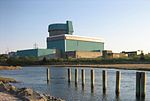Shoreham-Wading River High School
1975 establishments in New York (state)Brookhaven, New YorkEducational institutions established in 1975New York (state) school stubsPublic high schools in New York (state) ... and 1 more
Schools in Suffolk County, New York
Shoreham-Wading River High School is a public secondary school located in Shoreham, New York. The school serves about 800 students in grades 9 to 12 in the Shoreham-Wading River Central School District.
Excerpt from the Wikipedia article Shoreham-Wading River High School (License: CC BY-SA 3.0, Authors).Shoreham-Wading River High School
Route 25A,
Geographical coordinates (GPS) Address Nearby Places Show on map
Geographical coordinates (GPS)
| Latitude | Longitude |
|---|---|
| N 40.941695 ° | E -72.866971 ° |
Address
Shoreham-Wading River High School
Route 25A 250B
11786
New York, United States
Open on Google Maps









